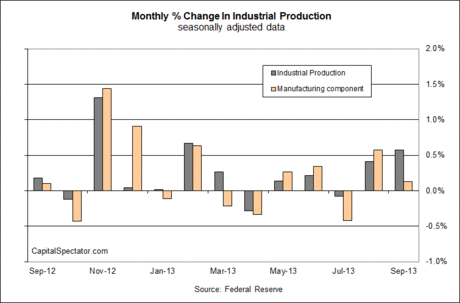Industrial production beat expectations and increased 0.6% in September vs. August, the best monthly comparison since February, the Federal Reserve reports. The year-over-year change turned higher as well, with output expanding 3.2% last month vs. a year earlier—the biggest annual gain since last November. But the upside surprise was due mostly to factors other than manufacturing, which rose a sluggish 0.1% last month. Is the mismatch a sign of trouble ahead? When ever the cyclically sensitive manufacturing sector wobbles, there’s always room to wonder about what comes next. It’s too early to say, of course, although today’s mixed report won’t be easy to dismiss until or if we see better numbers in the economic updates to come, starting with tomorrow’s delayed retail sales numbers for September.
Meantime, let’s take a minute and bask in the top-line 0.6% pop for industrial production, which certainly looks good at face value. If nothing else, this number dismisses the immediate worry that last month was slipping off the cyclical edge on the eve Washington’s latest installment of insanity. As for the weak manufacturing profile last month, today’s release isn’t terribly surprising in light of last week’s news that the Markit Flash U.S. Manufacturing Purchasing Managers Index has been slipping lately and fell to a 12-month low this month. “The flash
PMI provides the first insight into how business fared against the backdrop of the government shutdown in October, and suggests that the disruptions and uncertainty caused by the
crisis hit companies hard,” advised Chris Williamson, Markit’s chief economist (pdf). “The survey showed the first fall in manufacturing output since the height of the global financial crisis back in September 2009.”

Nonetheless, it’s encouraging to see industrial production’s annual trend turn higher, even if manufacturing’s not on board with the upswing at the moment. Thanks to the ongoing uncertainty linked to the government shutdown a few weeks ago, it’s premature to say that the manufacturing current weakness is a sign that the business cycle is stumbling or just a bout of temporary turbulence due to our friends in Washington.

“We are in a kind of status-quo, muddle-along mode,” Eric Green, global head of foreign exchange and rates at TD Securities, tells Bloomberg. Clarity is coming, and soon. By the end of the week we’ll have new data on retail sales, ADP private-sector employment, jobless claims, and the ISM Manufacturing Index. Meantime, cautious optimism prevails, albeit with some fine print.